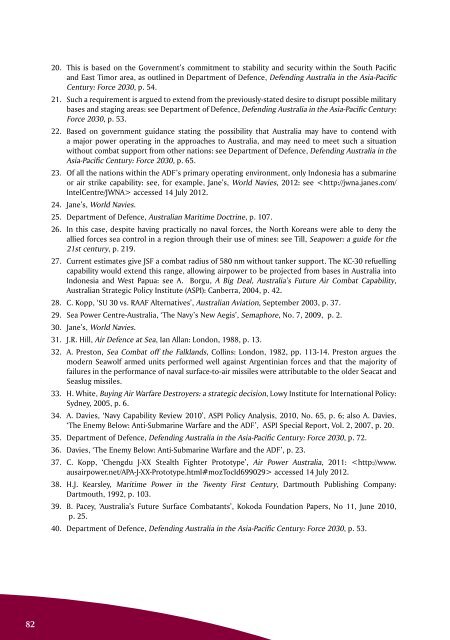190%202013%20Mar_Apr
190%202013%20Mar_Apr
190%202013%20Mar_Apr
Create successful ePaper yourself
Turn your PDF publications into a flip-book with our unique Google optimized e-Paper software.
82<br />
20. This is based on the Government’s commitment to stability and security within the South Pacific<br />
and East Timor area, as outlined in Department of Defence, Defending Australia in the Asia-Pacific<br />
Century: Force 2030, p. 54.<br />
21. Such a requirement is argued to extend from the previously-stated desire to disrupt possible military<br />
bases and staging areas: see Department of Defence, Defending Australia in the Asia-Pacific Century:<br />
Force 2030, p. 53.<br />
22. Based on government guidance stating the possibility that Australia may have to contend with<br />
a major power operating in the approaches to Australia, and may need to meet such a situation<br />
without combat support from other nations: see Department of Defence, Defending Australia in the<br />
Asia-Pacific Century: Force 2030, p. 65.<br />
23. Of all the nations within the ADF’s primary operating environment, only Indonesia has a submarine<br />
or air strike capability: see, for example, Jane’s, World Navies, 2012: see accessed 14 July 2012.<br />
24. Jane’s, World Navies.<br />
25. Department of Defence, Australian Maritime Doctrine, p. 107.<br />
26. In this case, despite having practically no naval forces, the North Koreans were able to deny the<br />
allied forces sea control in a region through their use of mines: see Till, Seapower: a guide for the<br />
21st century, p. 219.<br />
27. Current estimates give JSF a combat radius of 580 nm without tanker support. The KC-30 refuelling<br />
capability would extend this range, allowing airpower to be projected from bases in Australia into<br />
Indonesia and West Papua: see A. Borgu, A Big Deal, Australia’s Future Air Combat Capability,<br />
Australian Strategic Policy Institute (ASPI): Canberra, 2004, p. 42.<br />
28. C. Kopp, ‘SU 30 vs. RAAF Alternatives’, Australian Aviation, September 2003, p. 37.<br />
29. Sea Power Centre-Australia, ‘The Navy’s New Aegis’, Semaphore, No. 7, 2009, p. 2.<br />
30. Jane’s, World Navies.<br />
31. J.R. Hill, Air Defence at Sea, Ian Allan: London, 1988, p. 13.<br />
32. A. Preston, Sea Combat off the Falklands, Collins: London, 1982, pp. 113-14. Preston argues the<br />
modern Seawolf armed units performed well against Argentinian forces and that the majority of<br />
failures in the performance of naval surface-to-air missiles were attributable to the older Seacat and<br />
Seaslug missiles.<br />
33. H. White, Buying Air Warfare Destroyers: a strategic decision, Lowy Institute for International Policy:<br />
Sydney, 2005, p. 6.<br />
34. A. Davies, ‘Navy Capability Review 2010’, ASPI Policy Analysis, 2010, No. 65, p. 6; also A. Davies,<br />
‘The Enemy Below: Anti-Submarine Warfare and the ADF’, ASPI Special Report, Vol. 2, 2007, p. 20.<br />
35. Department of Defence, Defending Australia in the Asia-Pacific Century: Force 2030, p. 72.<br />
36. Davies, ‘The Enemy Below: Anti-Submarine Warfare and the ADF’, p. 23.<br />
37. C. Kopp, ‘Chengdu J-XX Stealth Fighter Prototype’, Air Power Australia, 2011: accessed 14 July 2012.<br />
38. H.J. Kearsley, Maritime Power in the Twenty First Century, Dartmouth Publishing Company:<br />
Dartmouth, 1992, p. 103.<br />
39. B. Pacey, ‘Australia’s Future Surface Combatants’, Kokoda Foundation Papers, No 11, June 2010,<br />
p. 25.<br />
40. Department of Defence, Defending Australia in the Asia-Pacific Century: Force 2030, p. 53.


